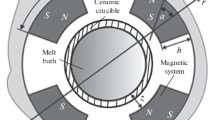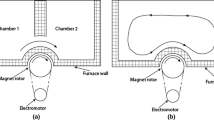Abstract
In order to obtain a uniform thermal distribution of a liquid metal melt in e.g. aluminum furnaces, mixing can be provided by rotating permanent magnets. A rotating permanent magnet generates a rotating magnetic field which induces a volume force in the nearby liquid metal. This paper presents a quick-and-dirty experimental and numerical study of temperature equalization with a permanent magnet for a liquid metal volume with a vertical temperature gradient. Thermocouples and a thermal camera have been used to capture the temperature dynamics. The setup consists of a thin walled stainless steel container filled with GaInSn eutectic alloy and a cylindrical NdFeB permanent magnet placed near the side wall. A parametric sweep has been performed by changing the inclination angle of the magnet in order to find the most efficient position for which the thermal balance can be achieved the fastest.








Similar content being viewed by others
Notes
Available at https://openfoam.org/
Available at http://www.elmerfem.org/
Available at http://gmsh.info/
Available at https://www.salome-platform.org/
Available at https://gitlab.com/eurocc-latvia/mhd-mixing-hpc-model
References
R. Cook, M. Varayud, S. Iijima, and E. Takahashi, Light metals (Springer, Cham, 2017)
J. Herbert, and B. Painter, Light metals (Springer, Cham, 2018)
A. Peel, and P.Y. Menet, J. Manuf. Sci. Prod. 15, 59 (2015)
A. Bojarevičs, R. Baranovskis, I. Kaldre, M. Milgrāvis, and T. Beinerts, IOP Conf. Ser.: Mater. Sci. Eng. 228, 012022 (2017)
J. Zeng, W. Chen, Y. Yang, and A. Mclean, Metall. Mater. Trans. B 48, 3083 (2017)
I. Bucenieks, Int. Conf. Nucl. Eng., Proc., 14th 42436, 185 (2006)
A. Bojarevičs, T. Beinerts, M. Sarma, and Y. Gelfgat, PAMIR Int. Conf. Fundam. Appl. MHD, 9th 2, 251 (2014)
I. Kaldre, A. Bojarevičs, T. Beinerts, R. Baranovskis, R. Nikoluskins, M. Milgrāvis, and M. Kalvāns, in IOP Conf. Ser.: Mater. Sci. Eng. 424, 012057 (2018)
A. Bojarevičs, and T. Beinerts, Magnetohydrodyn. 46, 333 (2010)
A. Peel, and J. Herbert, Light metals (Springer, Cham, 2016)
B. Willers, S. Eckert, P.A. Nikrityuk, D. Räbiger, J. Dong, K. Eckert, and G. Gerbeth, Metall. Mater. Trans. B 39, 304 (2008)
S. Eckert, P.A. Nikrityuk, B. Willers, D. Räbiger, N. Shevchenko, H. Neumann-Heyme, V. Travnikov, S. Odenbach, A. Voigt, and K. Eckert, Eur. Phys. J.: Spec. Top. 220, 123 (2013)
R. Baranovskis, M. Sarma, M. Ščepanskis, T. Beinerts, A. Gaile, S. Eckert, D. Räbiger, E. Lehmann, K. Thomsen, and P. Trtik, Magnetohydrodyn. 56, 43 (2020)
I. Grants, Phys. Fluids 33, 055115 (2021)
S. Eckert, and G. Gerbeth, Exp. Fluids 32, 542 (2002)
A. Cramer, C. Zhang, and S. Eckert, Flow Meas. Instrum. 15, 145 (2004)
M. Ščepanskis, M. Sarma, P. Vontobel, P. Trtik, K. Thomsen, A. Jakovičs, and T. Beinerts, Metall. Mater. Trans. B 48, 1045 (2017)
T. Lappan, M. Sarma, S. Heitkam, P. Trtik, D. Mannes, K. Eckert, and S. Eckert, Magnetohydrodyn. 56, 167 (2020)
D. Musaeva, E. Baake, A. Koppen, and P. Vontobel, Magnetohydrodyn. 53, 583 (2017)
S. Eckert, A. Cramer, and G. Gerbeth, Magnetohydrodynamics (Springer, Cham, 2007)
J. Stasiek, and T. Kowalewski, Optoelectron. Rev. 10, 1 (2002)
L.N. Fletcher, G. Orton, O. Mousis, P. Yanamandra-Fisher, P. Parrish, P. Irwin, B. Fisher, L. Vanzi, T. Fujiyoshi, T. Fuse, A. Simon-Miller, E. Edkins, T. Hayward, and J. De Buizer, Icarus 208, 306 (2010)
Y. Huang, J. Rong, J. Guo, W. Wang, Y. Wang, K. Lu, S. Guo, and L. Cao, Int. J. Therm. Sci. 170, 107144 (2021)
P. Oborin, S. Khripchenko, and E. Golbraikh, Magnetohydrodyn. 50, 291 (2014)
O. Ben-David, A. Levy, B. Mikhailovich, M. Avnaim, and A. Azulay, Int. J. Heat Mass Transfer 99, 882 (2016)
K. Bolotin, I. Smolyanov, E. Shvydkiy, V. Frizen, and S. Bychkov, Magnetohydrodyn. 53, 723 (2017)
V. Dzelme, A. Jegorovs, and A. Jakovics, IOP Conf. Ser.: Mater. Sci. Eng. 950, 012018 (2020)
L. del Campo, R.B. Pérez-Sáez, and M.J. Tello, Corros. Sci. 50, 194 (2008)
R. Monier, F. Thumerel, J. Chapuis, F. Soulie, and C. Bordreuil, Meas. 101, 72 (2017)
M. Cehlin, B. Moshfegh, and M. Sandberg, Proc. Room-Vent 339, 871 (2000)
Y. Plevachuk, V. Sklyarchuk, S. Eckert, G. Gerbeth, and R. Novakovic, J. Chem. Eng. Data 59, 757 (2014)
A.J. Reynolds, Turbulent flows in engineering (John Wiley London, New York, 1974), p. 462
J. Vencels, P. Råback, and V. Geza, SoftwareX 9, 68 (2019)
D. Berenis, R. Baranovskis, I. Grants, T. Beinerts, and A. Bojarevičs, Phys. Fluids 33, 055127 (2021)
Acknowledgements
This study has been financed by the European Regional Development Fund project “Electromagnetic technology for aluminium degassing process” under Grant No. 1.1.1.1/18/A/149. The HPC simulations were performed using the code developed as a part of the activities organized by the EuroCC National HPC Competence Centre of Latvia. D. Berenis received funding from project “Strengthening of the capacity of doctoral studies at the University of Latvia within the framework of the new doctoral model”, identification No. 8.2.2.0/20/I/006.
Author information
Authors and Affiliations
Corresponding author
Ethics declarations
Conflict of Interest
The authors declare that they have no conflict of interest.
Additional information
Publisher's Note
Springer Nature remains neutral with regard to jurisdictional claims in published maps and institutional affiliations.
Supplementary Information
Below is the link to the electronic supplementary material.
Supplementary file1 (MP4 13294 kb)
Supplementary file 2 (MP4 32752 kb)
Rights and permissions
About this article
Cite this article
Berga, K.K., Berenis, D., Kalvāns, M. et al. Model Experiment for Molten Metal Temperature Homogenization with Rotating Permanent Magnet. JOM 74, 2450–2460 (2022). https://doi.org/10.1007/s11837-022-05288-y
Received:
Accepted:
Published:
Issue Date:
DOI: https://doi.org/10.1007/s11837-022-05288-y




